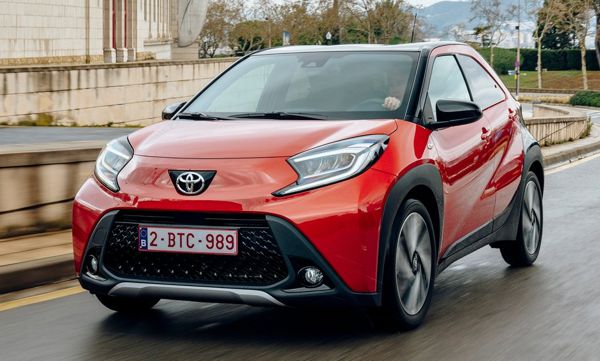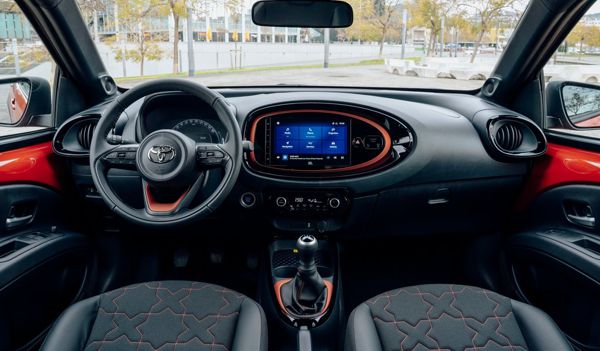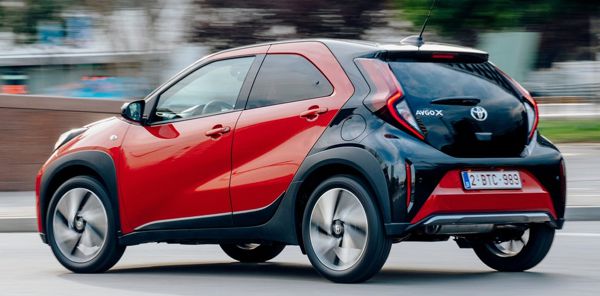Published
on 2
Jun 2024
|
All rights reserved.
|
|
|

|
|
Toyota
turns its smallest car into a crossover, kind of.
|
|
The first 2 generations of
Toyota Aygo was part of the joint-venture with PSA group in Czech
Republic, whose factory assembled Peugeot 108, Citroen C1 and the Aygo
on the same production line. However, due to the ever tightening
emissions and safety regulations in Europe, the French side considered
building A-segment small cars no longer profitable, so they withdrew
from the segment and sold their stakes to Toyota, which insists to
soldier on. Without the badge-engineered models to spread costs,
economy of scales will only get worse. How can Toyota keep fighting?
Frankly, I don’t know.
To catch the market trend of shifting towards SUV crossovers, Toyota
turned the Aygo into Aygo X, where X pronounces “Cross”. It looks
funkier and have some hints of an SUV, thanks to increased ride height,
enlarging the wheels to 18-inch and pushing them outward. The rubber
claddings around the wheel arches, bumpers and skirts give it a tougher
look and better scratch protection. The car has grown quite a lot, too,
being 245mm longer, 125mm wider and 65mm taller, while wheelbase is
stretched by 90mm. Kerb weight is up by exactly 100kg, which is a lot
to such a small car. However, it remains smaller than B-segment
superminis and still tips the scale at under 1000 kg.
The exterior design is radical, maybe not up to everyone’s taste, but
the 2-tone paint scheme is eye-catching. Apart from the glass tailgate,
it shares no genes with its predecessor, which is actually a good thing.

|
|
Interior
design looks like coming from the late 1990s, though everything is well
screwed together.
|
|
Inside, the round dashboard design looks outdated, more like coming
from the late 1990s. Predictably, the cabin is plasticky and all
plastics are hard ones, but at least Toyota’s build quality is not in
doubt, as parts are assembled solidly in place. The switches also have
a solid feel. The instrument is outdated, too, with a small digital
display flanked by analogue gauges. The touchscreen within that oval
console ranges from 6 to 8-inch, but Toyota’s infotainment system is
very basic in function and looks.
You sit higher in the Aygo X than typical small cars. The seat is not
adjustable for height, but the driving position is fundamentally
correct. There is more elbow room due to the enlarged body shell. The
rear bench remains tight for any adults, as it lacks both head and leg
room. Despite of the presence of rear doors, the door apertures are
actually small, and they are eaten by the large wheel arches, so the
rear seat is difficult to access, and almost impossible to fit a child
seat. Another downside for rear passengers is the lack of winding
windows.
These days Toyota is one of the few car makers persisting in developing
new engines, but on the Aygo X there is no evidence of that. The
1.0-liter VVT-i three-pot engine it employs has its roots tracked all
the way back to the first generation Aygo, and its output is hardly any
improvement from that car. It produces only 72 horsepower and 69
pound-foot of torque. Meanwhile, the car has gained 150 kg over the
years, no wonder 0-60 mph now takes a painful 14 seconds, compared to
mid-11 seconds of the original car. That’s a big difference in the real
world, especially when you gear up to overtake slower cars on highway.
 |
|
Decent
chassis fails to offset an underpowered engine.
|
|
At least, Toyota’s 5-speed manual gearbox is decent, whose gearshift
has short throws and a mechanical feel. Optional CVT is best to be
avoided, as it tends to thrash the engine heavily in acceleration.
The old engine is short of refinement, too. It vibrates in idle and
under acceleration. Sounds strained when being asked to work hard,
although it will calm down once settled on highway, by then the
excessive wind noise takes over as the main source of intrusion. Canvas
top option makes the latter problem even worse, and eats further into
the limited rear headroom.
Built on a modified version of Yaris’ TNGA-B platform, the Aygo X
corners quite well. It offers decent grip and body control, especially
for a tall car. Considering its short wheelbase and 18-inch wheels
fitted, ride comfort is surprisingly matured, but not quite as
absorbent or quiet as a Volkswagen Up or Hyundai i10. The steering is
well-weighted and precise, in combination with a short turning radius
gives the car an agile feel. However, push it too hard and the
stability control will intervene immediately, killing any hopes for fun.
Overall, the Aygo X is a decent small car, not a remarkable one, but
more interesting when its funky look is taken into account.
Unfortunately, with everything goes up, so does its pricing. A fully
loaded Aygo X gets well into the territory of some mid-range B-segment
superminis, which are more spacious, faster and significantly more
refined. Perhaps Toyota needs to rethink about its small car strategy.
|
Verdict:    |
|